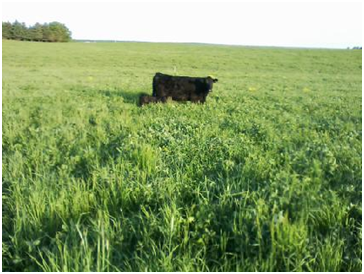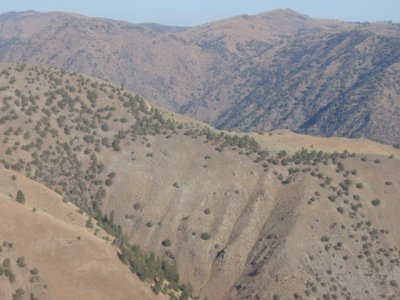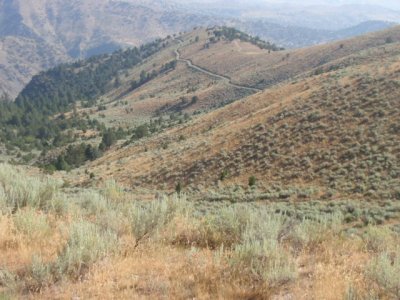Value of the pasture is ENTIRELY dependent upon it's CURRENT condition, the quality of the "improvements", and it's potential to put weight on animals, MINUS any requirements placed on the renter for investment into the property in $$$ and labor. Regardless of whether the "renter in past years" took care of it or not, it's now in the condition it's currently in, and you can't expect to get "top dollar" or even "average dollar" for a property that's right now "a damn mess".
Do you expect the renter for the coming season to clear it of weeds, brush, and cedar trees, fix/replace the fences and install fencing to keep the animals out of the ponds,, improve the pasture quality with reseeding and fertilization, mow and remove dead cows? How about installing watering facilities? If that's the case, it sounds to me like THAT would be a renter you'll want to keep long term, because he's doing an awful lot (think $$$ and time) to improve YOUR pasture. These are some pretty lofty expectations, and you might want to consider "free rent" for a number of years, followed by a "reasonable" rate that would take into consideration all that he's done for YOU.
Fencing is a permanent investment... and legally, anything that's stuck into the soil belongs to the property (i.e.: that'd be YOU). Unless it's written into the contract that he can take it back out when he leaves (another expense in $$ and labor), he technically would have to leave it, even if he installed it all and paid for it all. Water lines would be the same. So would the seeding he might do, and fertilizer. He'd be improving YOUR property for YOU, which he then is "renting" from you.
My point is, if you want the RENTER to make all of these improvements, you HAVE to take that into consideration when determining a "fair" price on the rent. This has to work for both of you, or it won't work for either of you. Too many times, BOTH parties forget that, and are in it all for themself. Take care of each other in this deal... because you're in it together! If YOUR not willing to make the investment at least in $$$ to OFFER a property (which YOU own, including the improvements) with those improvements on it already to your renter, why in the world would you ever think that HE would want to make that investment, just to leave it all behind in YOUR possession, if he were to lose that property?
Klm3030,
To help make my point, let's compare two potential properties.
Here's a picture of "some pasture"... let's assume it's got brand new HT electric perimeter fencing powered by a high joule AC fencer, plus 1 wire subdivision fencing in 10 acre paddocks. It's got distributed pressurized, frost free water on it, and a good corral system and loading facility in place. It's high in fertility converted cropland, filled with high yielding, highly diverse, high quality perennial forages. This pasture has deep black loam soils with very little to no sand, underlayed with deep silty clay loam, and on average receives about 40" of rain typically well dispersed throughout the growing season, and none of it is wetlands or subject to flooding. All of the permanent infrastructure maintenance and upkeep that is a part of the property (fencing, water system, corrals, roadways, pasture reseeding, etc.) will be paid for and maintained by the pasture owner.

And here's another "pasture", let's just assume that this one is similar in size, has semi-acceptable but 40+ year old badly rusted and heavily patched barbed wire fence with all wooden posts, no subdivision fencing, one pond with no fence around it that typically dries up in late July, unless it's a wet year. Any water beyond this will have to be hauled in. The property receives about 20" of rainfall per year through the growing season, soils are rocky sandy loam, the fertility is poor, there is no corral system or load out facilities. Any and all "property maintenance" and fencing, etc., is up to the "renter" to take care of, as it's owned by an "absentee landowner" that lives in a neighboring state about 200 miles away, but the renter is generally expected to "improve" the property (language that's stated in conversation, but never spelled out in writing). However, any fencing, watering systems, fertility amendments, or "seeding" that the renter might choose to do that's anchored into or applied to the soil will be done fully at his expense but is intended to "remain with the property" (he can't take any fence, corrals or watering systems anchored into the soil in any way that he might put in back out unless they're "portable/temporary" systems, and there will be no compensation/rent adjustment for fertility or seeding improvements, brush clearing, mowing or herbicide application).

Which of these two properties would you choose for YOUR cattle to graze on, if the "price per acre" you could get them for was relatively similar for both? There's just no way that these two properties are "comparable" for "value" to the cattle owner renter, and the respective rents will have to reflect that. Often, this is the scenario that is faced by the pasture renter however... "pasture is pasture" is how the landowner views it, and so "the county average" or slightly above it ought to apply. You have to keep in mind that in most cases, "pasture ground" is relegated to the marginal ground that "isn't suitable" for "cropping". And therefore, typically it is HIGHLY variable even within every section, let alone across a whole county or region..... it'll generally be of "poor quality and condition".... i.e.: areas that are too wet, too dry, too rocky, too shallow, sandy, heavily wooded, overgrown with brush... ground that's just hard to make a living out of. Hard enough that it becomes difficult to justify spending any money on it, even the "minimal cost" of putting a fence around it to hold in livestock. That doesn't change just because somebody else is owning the cattle and they're hard up to find some space to run them on.
Every property "is what it is" at the time, and that can't be overlooked. It is what it is... right now, when your wanting to rent it. Period. Unless you now, as the property owner, are willing to "take the property from the second example" and INVEST what it takes in it to turn it into "the property from the first example", you can't expect to be able to rent it for anything even remotely close to the same price per acre. Past history is just that... past history. It's yours now, and you inherited it in the condition it's in right now, not the condition it may or may not have been in 20 some years ago. You can be frustrated with what the renter in the past may have or may not have done with it... but that won't change the facts about "what it is" today. You can drop him cold, and exchange him for another renter, and that's your prerogative. Or, you can honor the commitment you made to your aunt from whom you inherited this property, and talk with the renter and
work WITH him as though he's your PARTNER to help improve the property from this point forward, now that it's in YOUR power to be able to do that.





